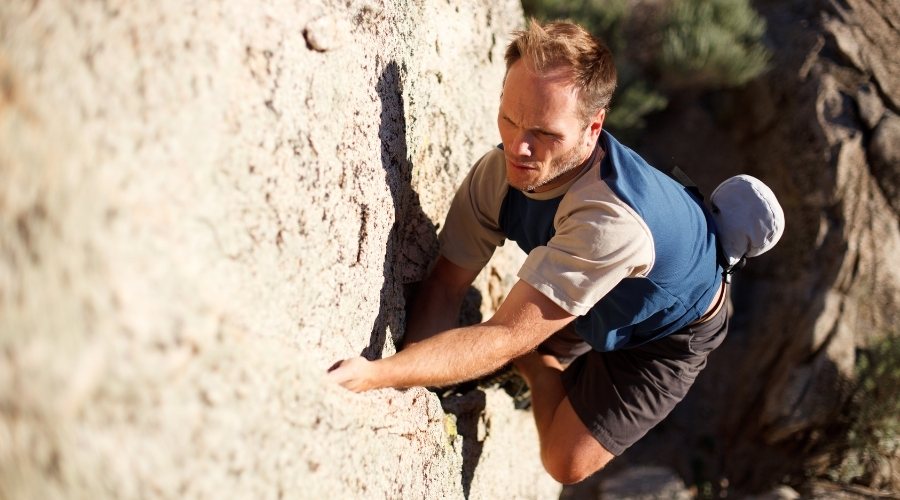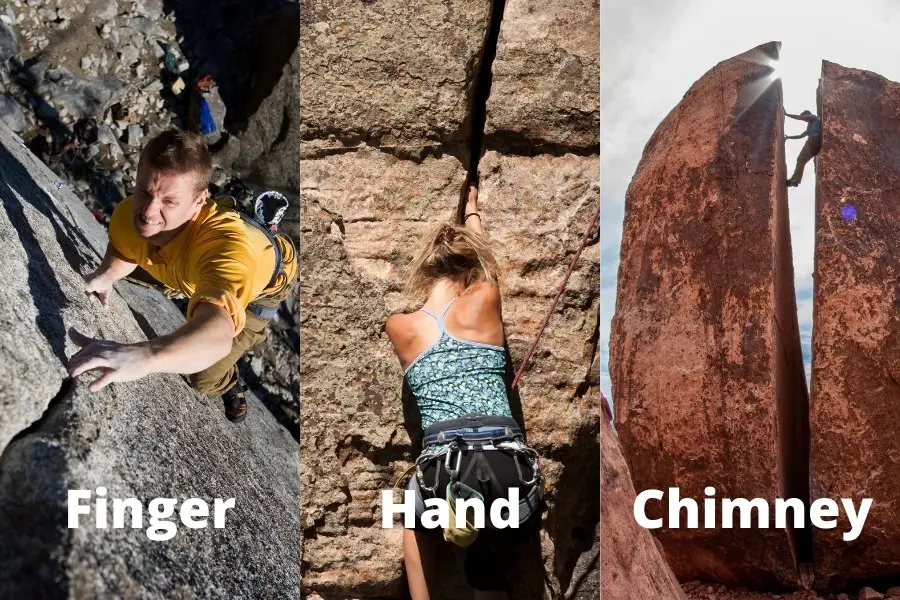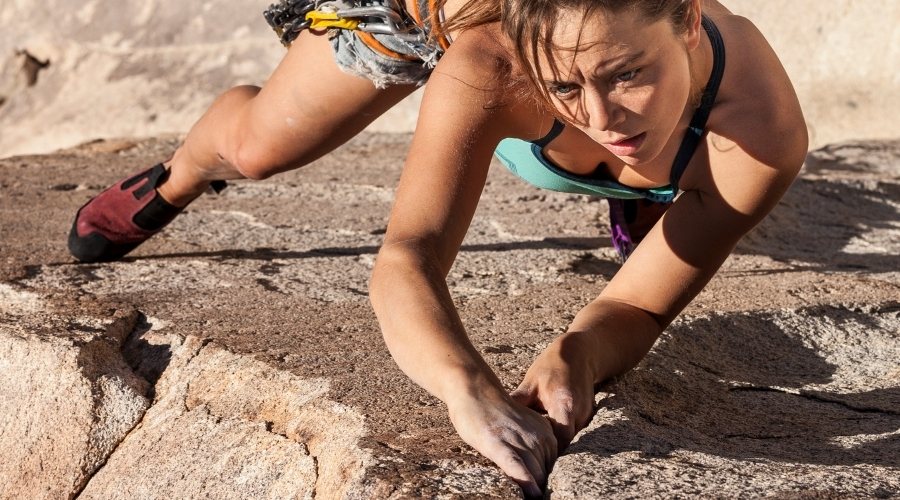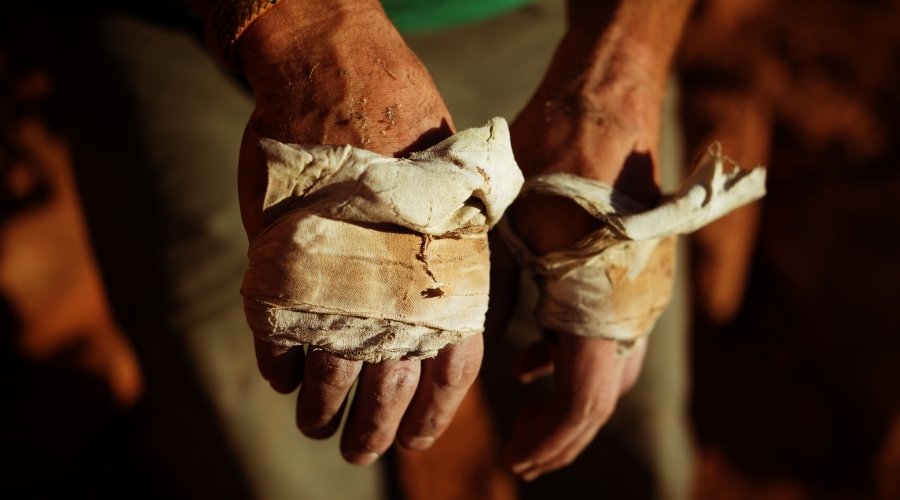Crack climbing is a very divisive climbing discipline. Some climbers absolutely love it and want to crack climb all day everyday. Other climbers loathe cracks and do everything in their power to avoid them. Why is this? Is it because crack climbing is harder than other forms of climbing?
On average, crack climbing is hard for inexperienced crack climbers and becomes easier with improved technique. The difficulty of a crack climb depends on the route’s angle (slab, vertical, or overhanging), width of the crack, and availability of holds nearby the crack.
Many factors go into determining how hard crack climbing is and is very climber specific. Some climbers will be much better at it and like it a lot more than others. This article explores just how hard crack climbing typically is for climbers, how its grading system works, and exactly what you can expect while crack climbing.
Factors That Determine Crack Climbing Difficulty

Crack climbing is much different than face climbing, and as such, how hard it is depends on very different factors than what makes a face climb hard. To see the main differences between crack climbing and face climbing check out my article linked here. It discusses the two disciplines and why exactly they are so different.
On average, crack climbing is easier than face climbing for climbers who lack grip and finger strength but have good technique and upper body strength. Crack climbing is harder than face climbing for climbers who have good finger and grip strength but lack technique.
The difficulty of a crack climb depends on the angle of the route (slab, vertical, overhang), crack width, and accessible holds nearby the crack.
Route Angle
This is pretty much what you would expect. A crack on an overhanging route will be much more difficult to climb than the same crack on a slab. More technique and physicality is required to climb cracks on steeper the routes. Typically, the steeper the route, the more technique and physicality that is required.
As a general rule, the difficulty of a crack climb increases as the route gets steeper. Overhanging cracks typically require climbers to have great technique and fitness to climb.
Crack Width

If you do not know the different crack climbing sizes, I highly recommend reading my article here. The remainder of the article will be referring to the different sizes and I don’t want you to be confused.
The easiest crack size to climb are hand cracks. Hand cracks provide climbers with solid foot and hand jams that allow them to climb the crack without advanced crack climbing technique.
Moderately difficult crack sizes include chimneys and off-finger cracks. These require a decent level of technique to climb but are not impossible for climbers who are in decent shape and understand the fundamentals of crack climbing.
Finger cracks are harder to climb than hands, off-fingers, and chimneys. They typically require a high level of crack climbing technique and typically do not provide climbers with any good foot or hand placements.
Off-widths are widely considered to be the hardest crack size to climb. They require the most technique and physicality of all the sizes. Becoming proficient in off-width climbing requires a lot of work and effort for most climbers due to the awkward crack width.
Nearby Hold Availability
As with route angle, this factor is also pretty intuitive. Crack climbs are easier when there are other holds available nearby the crack. This provides climbers more hold choices and allows them to have better hand and foot placements.
As a general rule, a crack climb will be easier with more good holds nearby the crack. A crack climb will typically be harder on walls that do not have holds nearby the main crack.
Explaining Crack Climbing Grades

Crack climbs are assigned a grade using the same scale(s) as face climbing such as the Yosemite Decimal System (YDS) 5.0 to 5.15c, French/sport 1 to 9c, etc. As such, the easier crack climbs will be graded lower than the more difficult ones. That said, all climbing grades are subjective and should be taken with a grade of salt.
Easy crack climbs will typically be graded 5.0 to 5.9. These will typically be slabby to vertical hand cracks with good footholds and various other holds available nearby the crack. These routes typically do not require a significant amount of crack climbing technique or fitness to climb.
Moderately difficult crack climbs will typically be graded between 5.10a and 5.12d. Moderately difficult cracks will typically be vertical off-finger to hand cracks with decent footholds. A significant amount of crack climbing technique and a base level of fitness are required to climb them.
Hard crack climbs will typically be graded 5.13a and above. They will be vertical to overhanging and will typically be finger cracks or off-widths with bad footholds and complicated jams. Hard crack climbs are very complex and require highly technical moves and a high level of fitness to climb.
What to Expect Crack Climbing

What you can expect when crack climbing really depends on how you start. I highly recommend to start in a gym setting on the easier hand cracks. This will allow you to climb cracks that are not incredibly abrasive and learn basic crack climbing technique relatively quickly.
That said, do not expect to be a world class crack climber within your first few lessons. As mentioned above, crack climbing is completely different than face climbing and the two do not transfer over well. Honestly, you should expect to be bad at it. It will almost be like learning how to climb all over again.
In addition to this, you can probably expect crack climbing to not be the most comfortable thing in the world. In fact, crack climbing has become notorious in the climbing community for being painful.
How Much Crack Climbing Hurts
Crack climbing is commonly reported to be painful to climber’s feet and hands (especially for newer and more inexperienced crack climbers).
The nature of crack climbing is to shove as much of your fingers/hands/body into the crack as possible to get the best hold. This in turn will commonly cause climbers to get a lot of scrapes and bruises on their fingers and back of their hands.
In addition to this, climbers will be twisting their feet into cracks and this can be very uncomfortable when done properly to very painful when done incorrectly.
Having improper technique will exacerbate these pains because climbers will slip out of the rock more (increased scrapes) and will not be using their feet correctly.
The following are three ways to make crack climbing less painful:
- Use proper crack climbing shoes
- Wear crack gloves or tape
- Develop better crack climbing technique
Check out my article that explores the best gear for crack climbing including the best crack gloves and shoes currently on the market.
